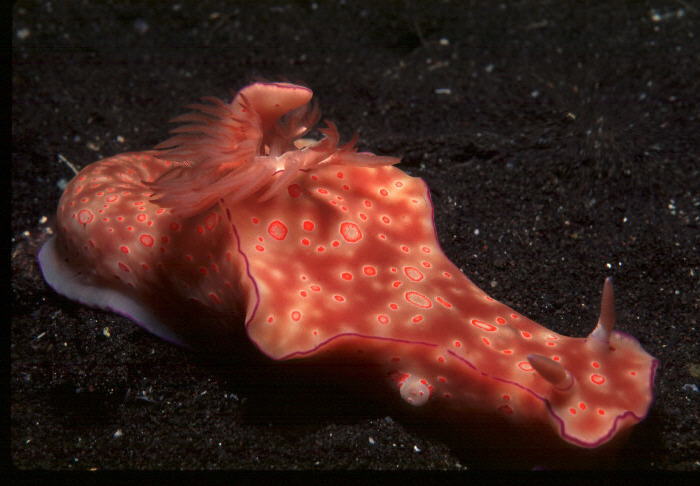 |
Ceratosoma trilobatum
Tulamben, Bali, Indonesia, Oct. '98
Ceratosoma trilobatum (J.E. Gray, 1827)
This weeks "Branch in the Spotlight" is Ceratosoma trilobatum (J.E. Gray, 1827). When I think of the genus Ceratosoma, this species, with its conspicuously widened, three lobed, table like mantle is the first to come to mind. The genus, however, contains some of the "spaciest" looking slugs of the Nudibranchia. In most cases, they are dorid in body shape, with retractile gills and are therefore cryptobranch dorids. A member of the family Chromodorididae their external body shape varies from the more classical discoid Chromodoris body shape in Ceratosoma amoena, to a more elongate Hypselodoris form in C. brevicaudatum, to the cynically outrageous Ceratosoma alleni . Obviously, Ceratosoma trilobatum is more your middle of the road shape, the one most of us associate with the genus.
Ceratosoma trilobatum, like others in the genus has a hard, almost rigid body with a long tapering foot and highly branched gills set between the three rounded triangular lobes of the mantle, one to each side and one arching over the gill, posteriorly. The body color is orange to brown, with some specimens variably bearing red-orange rings scattered over their surface. In this specimen, each ring is situated on a lighter, sometimes white background area. It also has a characteristic thin purple band along the notal edge. Mike's photo shown here, is the most typical color variant and was taken in Tulamben, Indonesia. Debelius pictures a similar specimen shot by Fred Bavendam in North Sulawesi, Indonesia. Specimens without spots, as shown in this link are common in the Batangas region of the Philippine Islands, and shown in Wells & Bryce from Western Australia. The most important feature is the three dorsal lobes.
C. trilobatum has a wide geographic range, occurring within the Red Sea eastward to Australia and Indonesia. This species is a common reef inhabitant reaching 11 cm in length
Like many chromodorids, the aposomatically colored Ceratosoma have mantle glands producing pungent noxious secretions used in their defense against predators.
Just when you think you've seen them all, up pops a new addition. Denise Tackett, visitor to the Kungkungan Bay Resort in Sulawesi, Indonesia recently shared this new Ceratosoma with us. When Gosliner described C. alleni in 1996, I thought we were having some sort of Ceratosoma out-of-body experience, but this beast crawling on the dark sands of the Lembeh bottom, with its triangular star shaped notal appendages, mimicing some yellow branched sponge, completely blows my mind. What's next?
Darn it Denise, the next time you see this critter please bag me a specimen,
so we give it a name for perpetuity.
Taxonomic information courtesy of Dave Behrens
Photograph by the Webmaster

David W. Behrens
Author:
Pacific Coast Nudibranchs
Send Dave mail at seachalleng@earthlink.net
|
